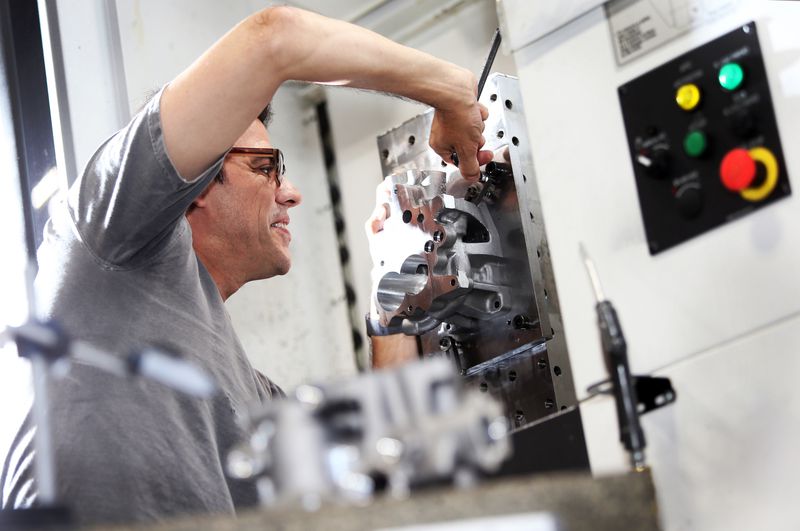Work-Based Learning Network (WBLN)
Hartford’s public/private All In! Coalition launched the Hartford Work-Based Learning Network (WBLN) in July 2018. Our charge is to serve as a learning community of practice to define and maximize implementation of sustainable Work-Based Learning (WBL) strategies that ensure Hartford high school students’ readiness for post-secondary success in higher education, skills training and career advancement.
Capital Workforce Partners (CWP) – the regional workforce development board for North Central Connecticut – serves as WBLN’s backbone organization, with additional support from Achieve Hartford. WBLN partners include: City of Hartford Department of Children, Families, Youth and Recreation); Hartford Public Schools; Blue Hills Civic Association; Center for Latino Progress; Forge City Works; Our Piece of the Pie; ReadyCT; United Way of Central and Northeastern CT; and Urban League of Greater Hartford.
Quality WBL initiatives provide students opportunities to acquire relevant academic, technical and workplace professional skills. Regardless of industry, employers consistently underscore that workers need experience and mastery in key skill areas, with a growing emphasis on developing core employability skills. To help students in developing these skills, authentic workplace experiences are crucial, combined/integrated with academic study/classroom instruction and other college and career-readiness activities. Guest speakers, career days, career mentoring, workplace tours, informational interviews, job shadowing, mock interviews, workplace challenges, internships and work experiences, etc. provide real-world context and the opportunity to learn about the workplace in practical terms. Providing authentic workplace experiences and bringing employers into the classroom as part of the readiness process creates powerful learning experiences and deepens students’ education experience.
DEFINITION: Work-Based Learning (WBL) Defined
WBL Working Definition
Consistent with research into WBL efforts nationally and their own practical experience, WBLN partners agreed on the following definition to frame our collective efforts. This definition informs the various WBL programs operating in Hartford with alignment to emerging statewide consensus definitions and elevated best practices.
Work-Based Learning is a multi-year sequenced continuum of integrated classroom instruction and workplace-based learning experiences resulting in participating (high school) students’ readiness for post-secondary career advancement (including higher education), featuring the following components:
- Curriculum with robust and integrated classroom instruction, enabling the transfer of knowledge and coordination of academic learning with the worksite experience.
- Multiple opportunities for employer engagement, mentorship and feedback to both the student and classroom teachers.
- Creation of individualized career advancement plans recorded in student success plans. Including career awareness, exploration and preparation.
- Formal work-based internship or culminating experience with employer-supervised hands-on learning work activity, multiple avenues for teacher input and observation.
- Support service plan, including transportation, tools, equipment, etc. to sustain student participation, including parent(s), school staff, mentor and employer.
- Objective assessment, documenting student readiness and, if applicable, relevant industry validated credential(s).
WBLN Audiences
Effective WBL systems are mutually beneficial to students, industry partners, and educators, with a shared understanding that classroom instruction is aligned to workplace competencies. Other stakeholders, including community-based organizations and policymakers, support this collaborative ecosystem by clarifying and addressing gaps or mismatches as they arise.
Students: Work-Based Learning helps students gain exposure to the workplace while still in school, leading to many benefits. Through WBL activities, students build awareness of potential careers in a particular industry and can explore options and start preparing for their future. WBL provides opportunities for hands-on learning and development of relationships with professional adult role models. Participating students acquire experience and build core employability and occupational skills while learning about the training and education required to succeed in specific careers. They are better able to understand real-world applications of academics to help answer the question. “Why do I need to learn this?” By integrating a range of workplace exposures and experiences with school-based activities and guidance over time, students set their sights higher than an immediate job and are more likely to remain committed to their education through completion of their personal and career-related goals. Typically, WBL-participating students can:
- Make connections between real work expectations and the classroom.
- Begin to pursue education with a greater sense of purpose.
- Interact with positive adult role models in a reduced student-adult ratio.
- Experience enriched opportunities to learn, perform and be recognized.
- Develop new skills and experiences.
- Experience enhanced self-esteem.
- Expand horizons and awareness of future work options.
- Experience a range of opportunities not traditional for their gender, race or ethnicity.
Employers / Industry Partners: Participating in WBL offers employers an effective vehicle to help build and retain their future workforce. Metro Hartford businesses/employers in multiple key sectors report a rapidly growing mismatch between the skills required for entry into their respective industries and those of the emerging local workforce. By opening their places of business to students and providing high-value WBL opportunities, employers can benefit from productive student work and gain a new perspective. Employers can observe potential future employees in a “long-term interview” context and participate in shaping their future workforce. Students also provide access to a key potential customer resource and informative point of view.
An employer’s existing incumbent workforce benefits from working with more productive and engaged employees and the opportunity to develop leadership and supervisory skills. WBL participation provides an opportunity for companies to support local schools, help develop a skilled and productive future workforce, build community awareness of the company’s role in the local economy, and enhance public image. Typically, WBL-participating employers can:
- Build long-term relationships with local schools, helping to produce candidates qualified for entry-level employment upon high school graduation.
- Obtain assistance with staffing and project needs.
- Evaluate future hiring decisions on knowledge and observation of student work.
- Gain organizational awareness for attracting additional qualified candidates.
- Have the opportunity to mentor students in careers associated with business needs.
Schools, Educators, Training Providers: WBL extends the classroom to the workplace and brings employer volunteers into the school and classroom. It helps build educators’ awareness of industry-identified skills to incorporate in the classroom/academic curriculum and validates curriculum instructional models. It provides touchstones in authentic workplaces to help make classroom learning relevant and helps schools and programs build relationships with the community. WBL provides opportunities for networking and relationship-building to promote future collaboration with employer partners.
- WBL assures students and parents that graduates will be well prepared for post-secondary education and promising career opportunities.
- WBL builds ties with local employers, connecting youth with career opportunities in numerous fields and occupations.
- WBL partners gain a better understanding of what business and industry expect.
- WBL participating schools, teachers and providers can improve their ability to adjust curricula and instruction to the needs of the work site.
- WBL participating schools, teachers and providers can improve collaboration with employers in preparing students for success in the workplace.
Community: WBL activities connect the local community to schools/education and local economic development efforts, promote civic engagement and help address community priorities and issues. Students complete community-focused projects to become more visible as productive and contributing community members of the larger society. WBL helps to grow a more productive and committed local workforce and demonstrates a commitment from schools/educators and businesses/employers to support expanded opportunities for local residents/citizens. Typically, WBL-participating communities
- Retain students, who intern with local companies as residents, stabilizing neighborhood populations.
- Experience an increase in local commerce, and home purchasing.
- Benefit from a decrease in unemployment.
- Gain strength as student community engagement increases.
WBL Continuum
The WBL sequence of age/grade/developmentally appropriate learning activities and experiences is intended to help students progress from career awareness, to career exploration, to career preparation, resulting in measurable post-secondary readiness. This continuum is purposively designed to be flexible and responsive to changing industry and student needs, with continuous improvements and updates informed through feedback loops between students, businesses, and educators. The WBL system in Hartford emphasizes accessibility and agility through multiple on-/off-ramps to entry for youth needing technical and professional skill development. The three levels of the WBL continuum, and corresponding typical activities are:
Career Awareness: Activities designed to promote awareness of careers, workplace norms and employer expectations, and understand personal interest and aptitudes. Typical WBL awareness activities include Guest Speakers, Career Days, Mentoring and Workplace Tours.
Career Exploration: Activities designed to promote deeper understanding of potential careers, and provide opportunities to investigate a particular industry, career or occupation of interest. Typical WBL exploration activities include Employer-Led Projects, Informational Interviews and Job Shadowing.
Career Preparation: Activities designed to provide an in-depth discovery of a particular career and developing the skills and understanding of education and training needed to succeed in a particular industry or occupation. Typical WBL preparation activities include Mock Interviews, Internships, Work Experience, Pre-Apprenticeship and Apprenticeship.
Hartford WBL Readiness Standards
To focus work-based learning efforts on achieving the shared goal of student post-secondary success, WBLN participants agree on the importance of meeting objective, practical, attainable readiness standards, validated by age/grade/developmentally appropriate assessment/evaluation. Building on their respective experiences implementing WBL programs and services and a foundation of 21st Century Career Competencies developed by CWP, WBLN endorses the following set of 12 Student Readiness Standards.
WBL Readiness Rubric and Evaluation Tools
DOWNLOAD: WBL Summative Evaluation Rubric
To assess participating WBL students’ state of readiness to meet these standards in a post-secondary environment, WBLN endorses the following summative evaluation rubric tool. This rubric is a guide. Intended to be used to expand decision-making around evaluative decisions. It is understood that each WBL project may have tasks that do not match specifically with each item.
DOWNLOAD: WBL Competencies Summative Evaluation Form
WBLN participants collaborated to develop and endorse the following evaluative tool aligned to the WBL Readiness Standards to measure student growth.
Additional Resources
Career Clusters, Career Pathways, and Programs of Study
There are 16 Career Clusters found in the National Career Clusters Framework which were developed in 1996 by the U.S. Department of Education, the Office of Vocational and Adult Education (OVAE), the National School-to-Work Office (NSTWO) and the National Skill Standards Board (NSSB). These clusters provide standardization and consistency across an ever-evolving labor market.

Online Toolkit Resources

Overview
Tool Descriptions
Pre-Employment Skills
Assessment Tools
Universal Tools
Manufacturing
Technology and Design
E-Portfolio Tools


All Tools
Supplemental Tool Information
Full Report (PDF)

Businesses

Jobseekers

Youth & Young Adults
Ages 14-24
